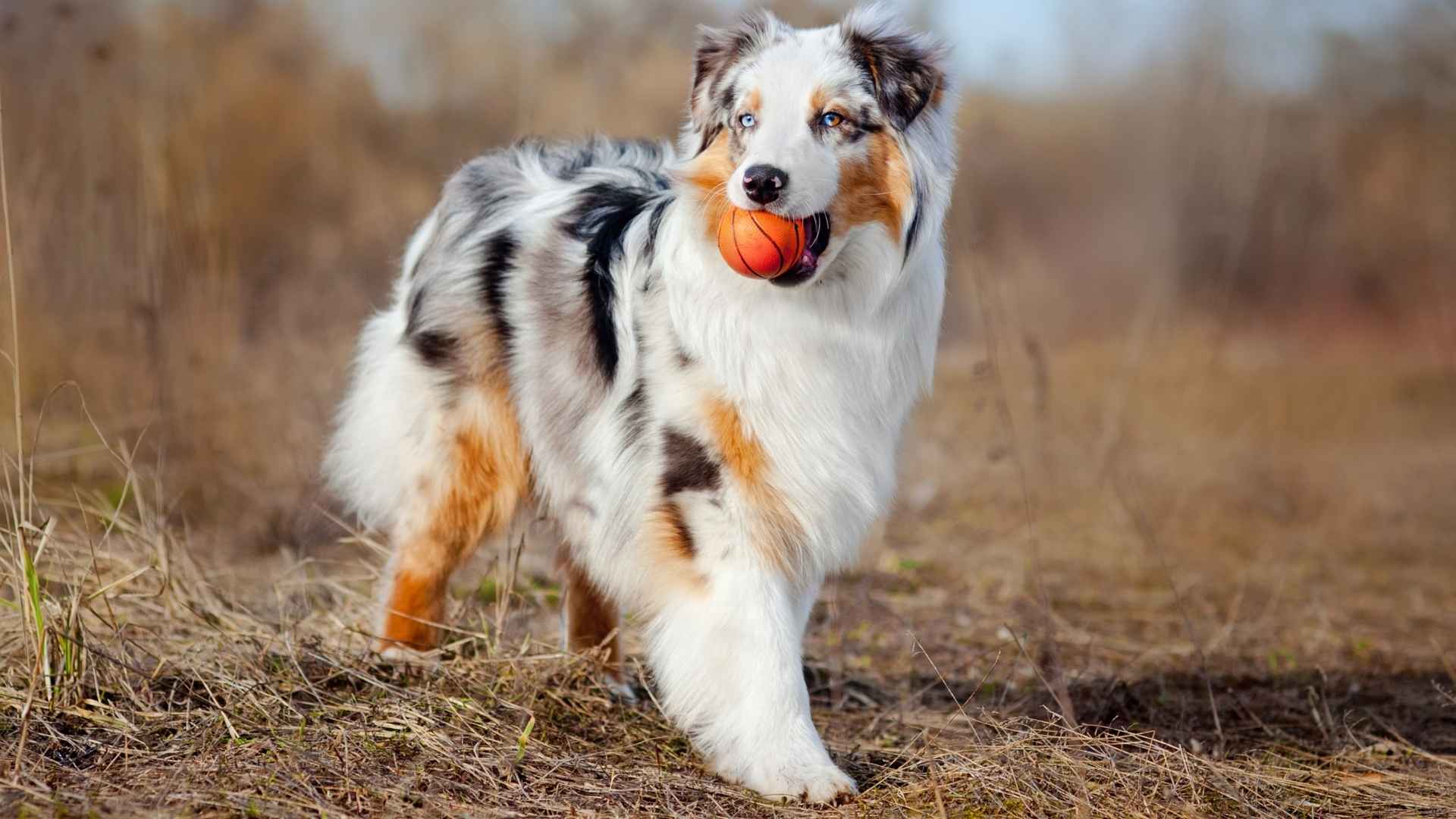If you’ve ever laid eyes on a dog with a marbled coat that looks like a swirled scoop of ice cream, chances are you’ve met a Merle! Merle dog breeds are total show-stoppers thanks to their signature mottled coats—think patchy swirls of black, tan, white, or even blue-grey. These pups often sport striking blue eyes that only add to their enchanting looks.
The Merle pattern isn’t a colour but a genetic trait that gives these dogs their magical coats and sometimes even unique skin pigmentation on their noses or paw pads.
Fun fact: In some breeds like the Dachshund, this pattern is called “dapple”—adorable, right? Merle coats come in all kinds of colour combos and patch sizes, making each dog truly one of a kind.
Whether you’re already smitten with the look or just discovering them, Merle dog breeds are as fascinating as they are fabulous. Let’s dive into their world!
Merle Dog Breeds
1. Australian Shepherd
Don’t let the name mislead you—Australian Shepherds were actually developed in the American West. These intelligent herders gained popularity in the late 1800s, drawing lineage from British herding breeds and possibly the smooth-faced Pyrenean Shepherd brought over by Basque immigrants.
Ranchers valued them for their relentless drive and courage, whether managing sheep, cattle, or even wild horses.
Among their many coat variations, the Blue Merle Australian Shepherd stands out with a marbled mix of blue-grey, black, and white, sometimes accented by tan, says the Kennel Club. While white patches are common, full tan points appear less frequently, adding to their unique appeal.
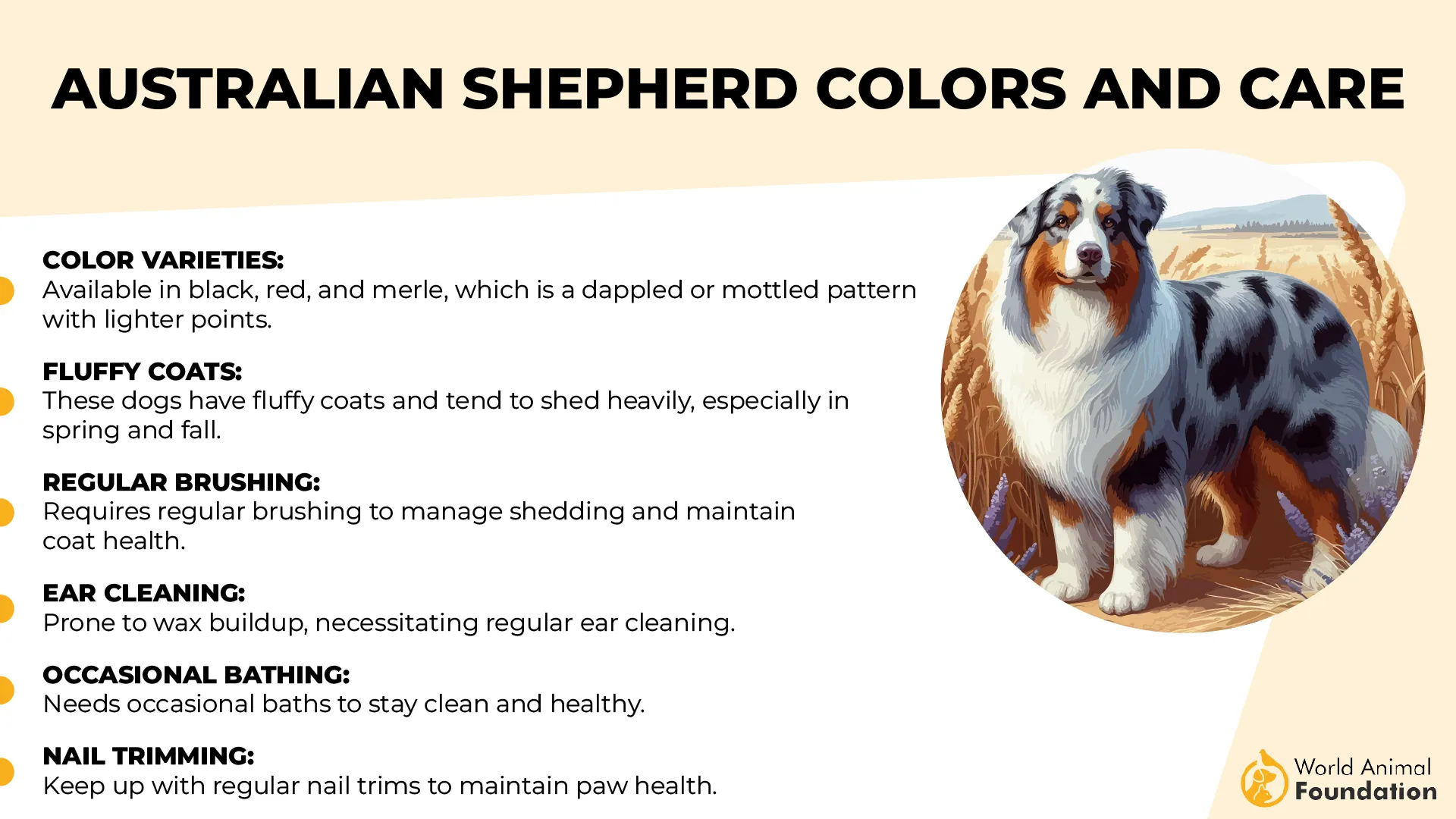
Aussies aren’t just beautiful—they’re wired for action. Highly intelligent and full of energy, they thrive when they have a task to focus on, whether it’s herding, agility training, or trail running. Without enough stimulation, they might redirect that energy into herding children, pets, or even household objects. It’s not misbehavior—it’s instinct looking for an outlet.
Those from working lines are especially high-energy, but all Aussies share traits like playfulness, quick learning, and responsiveness. They may be aloof with strangers, assertive with unfamiliar dogs, and can bark excessively. Their alert nature also makes them reliable watchdogs.
Did you know?
The blue merle coat pattern comes from a single copy of the merle allele. Breeding two merle dogs together can produce “double merle puppies,” which often have mostly white coats and face a high risk of vision and hearing issues. Responsible breeders avoid this and also screen to protect the puppies’ health.
2. Border Collie
Border Collies are often considered the smartest dogs around—medium-sized, agile, and bursting with energy. Bred along the England-Scotland border, they descend from generations of hardworking sheepdogs. Their alert expression and signature “herding eye” speak volumes about their intense focus and strong instincts.
Though Border Collies come in many colours, the merle variation is among the most eye-catching. These dogs usually have a base coat of black or red, marbled with lighter and darker patches. The black-based version is often called “blue,” while the red one carries a soft cinnamon hue.
Their coats may be paired with blue or mixed eyes, making them especially striking. True merling only appears on pigmented areas—white patches may have speckles, but those aren’t part of the merle gene pattern.
Their thick coats do shed, particularly during spring and fall. During these times, regular brushing is a must to manage the extra fur. Even outside of shedding seasons, they benefit from routine grooming to keep their coat healthy and looking sharp.
Border Collies are brilliant problem-solvers with an endless drive to work. American Kennel Club (AKC) refers to them as “champion herders”. Whether it’s herding, agility training, or fetch marathons, they crave activity and mental stimulation. Without a job or space to run, they’ll invent tasks—sometimes herding anything from pets to furniture.
Despite their energy, they’re incredibly loyal and affectionate with their families. While they can be reserved around strangers and sensitive to loud sounds, they form deep bonds with those they trust.
Fun Fact:
Not only are these dogs stars in the world of herding and agility, but they’ve also made their mark in pop culture. Remember Babe, the heartwarming movie about a pig who herds sheep? Yep, that clever canine co-star was a Border Collie!
3. Cardigan Welsh Corgi
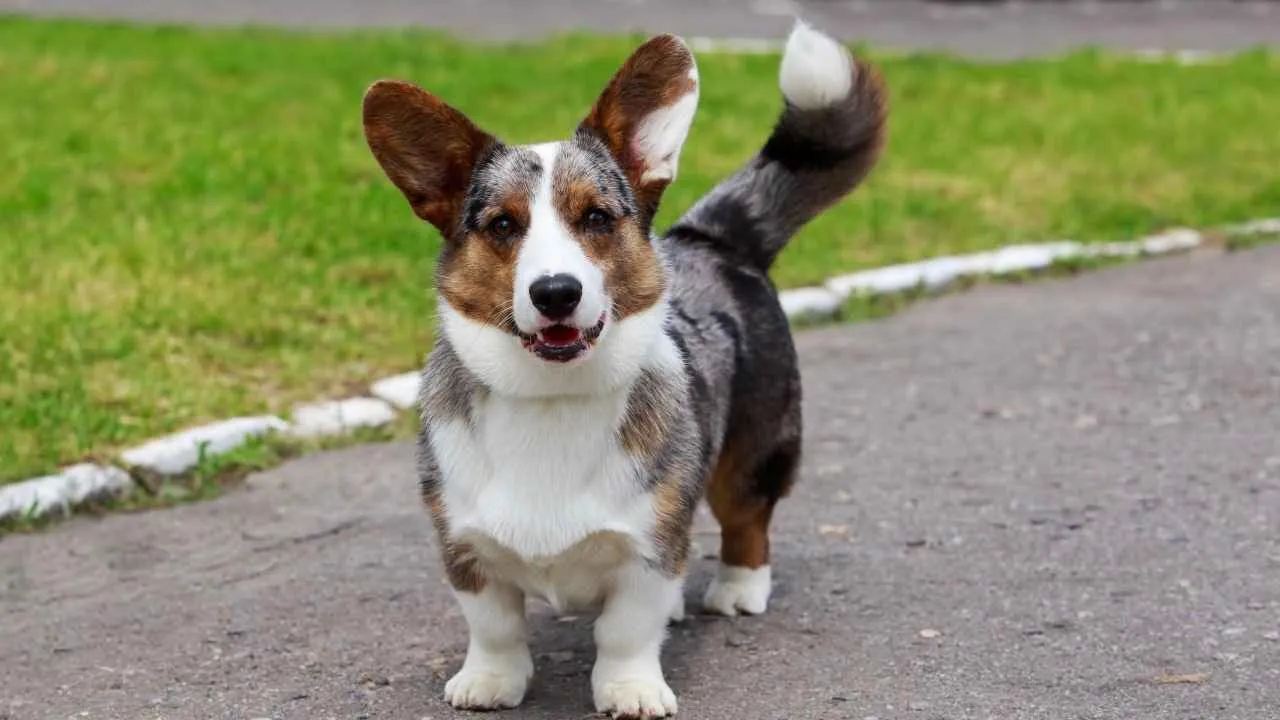
Cardigan Welsh Corgis may be low to the ground, but their charm is sky-high. With their short legs, oversized ears, and affectionate nature, these ancient herders have been winning hearts for centuries. Loyal, clever, and full of personality, they make wonderful companions for those seeking a trainable dog with a playful streak.
These sturdy little dogs were once called “yard dogs” because their length, nose to tail, measured about a Celtic yard. Their fox-like tail and low-set frame give them a distinctive look, complemented by a double coat in striking colours like red, black, blue merle, or tricolour, often with a white chest marking that adds to their appeal.
Despite their size, Cardis are active and agile, always ready for a game or a brisk walk. Originally bred to herd, they remain alert and energetic, with a deep bark that belies their stature. Yet after the action, they’re just as content curling up for a cuddle, fitting seamlessly into homes with children, other pets, or even apartment living.
Corgis are smart and quick learners, but they need engagement to stay out of trouble. Their strong herding instincts make them naturally protective and excellent watchdogs. With consistent activity and mental stimulation, they remain balanced, content, and well-behaved.
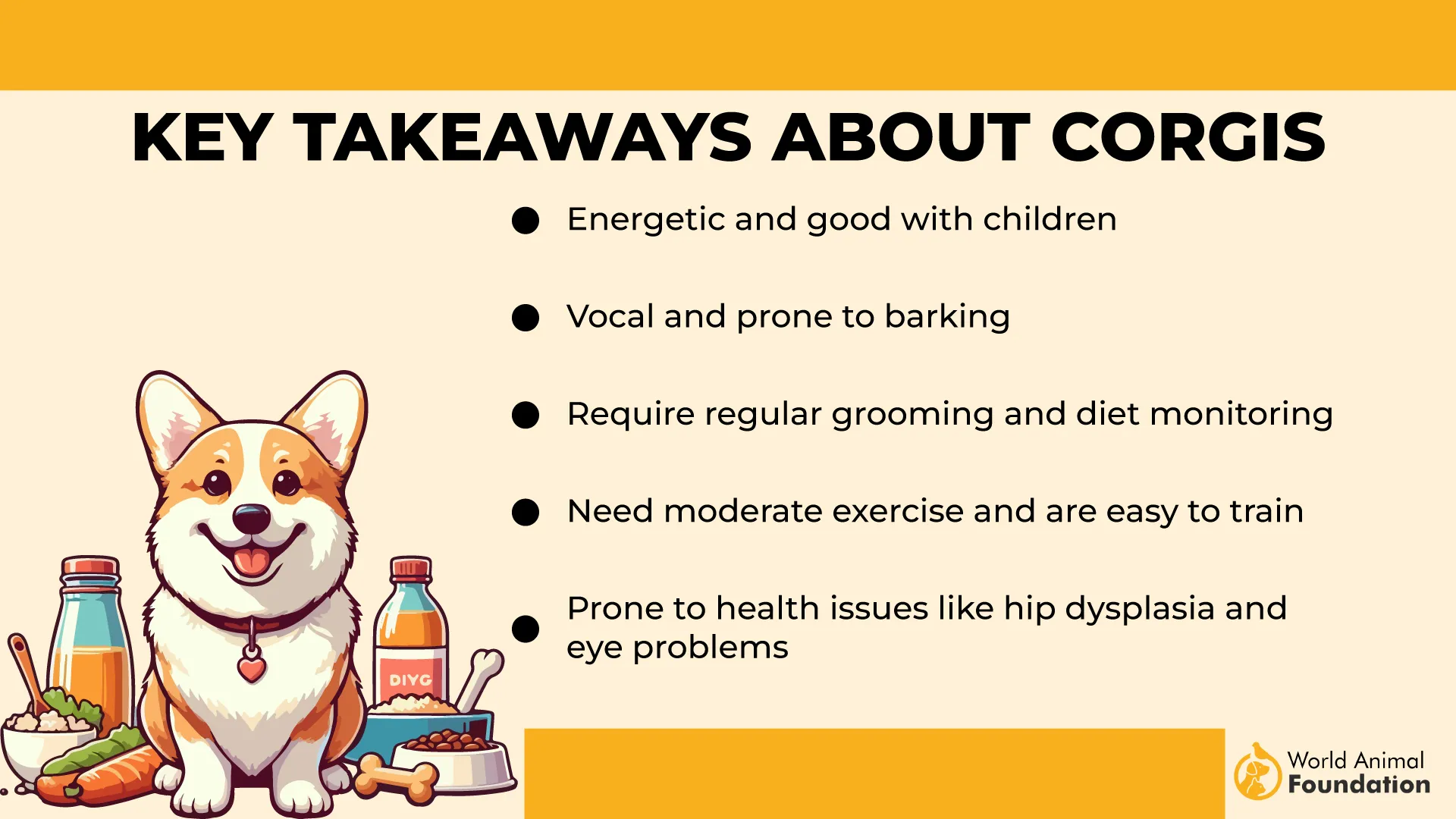
Though they’re full of energy, Cardis also enjoys downtime. They’re equally happy lounging indoors as they are exploring the outdoors. With daily exercise and some attention, they adapt beautifully to most lifestyles, always ready for a belly rub or a spot on the couch.
4. Catahoula Leopard Dog
With a name as bold as their appearance, the Catahoula Leopard Dog is truly one of a kind. Originating in Louisiana and named after a Choctaw word meaning “sacred lake,” these dogs are known for their stunning variety of coat colors and patterns, along with their striking eyes, often icy blue or uniquely marbled. No two look alike, which only adds to their allure.
Catahoulas are known for their dazzling merle coats, ranging from red and blue to brindle or solid colors, and their show-stopping eyes. Their unique appearance turns heads, but it’s their intelligence and loyalty that truly define them.
Hills Pet states that Catahoulas are driven, hardworking dogs with strong instincts. Bred for herding and hunting, they tackle tasks with intensity and focus. While they’re deeply loyal and affectionate with family, they can be wary of strangers and need confident, consistent training from an early age. Daily physical and mental activity is essential to keep them balanced.
These dogs are energetic, alert, and protective of their people. They bond strongly with their families but may be reserved around unfamiliar dogs or visitors, especially males who haven’t been raised together. Early socialization helps manage this territorial streak.
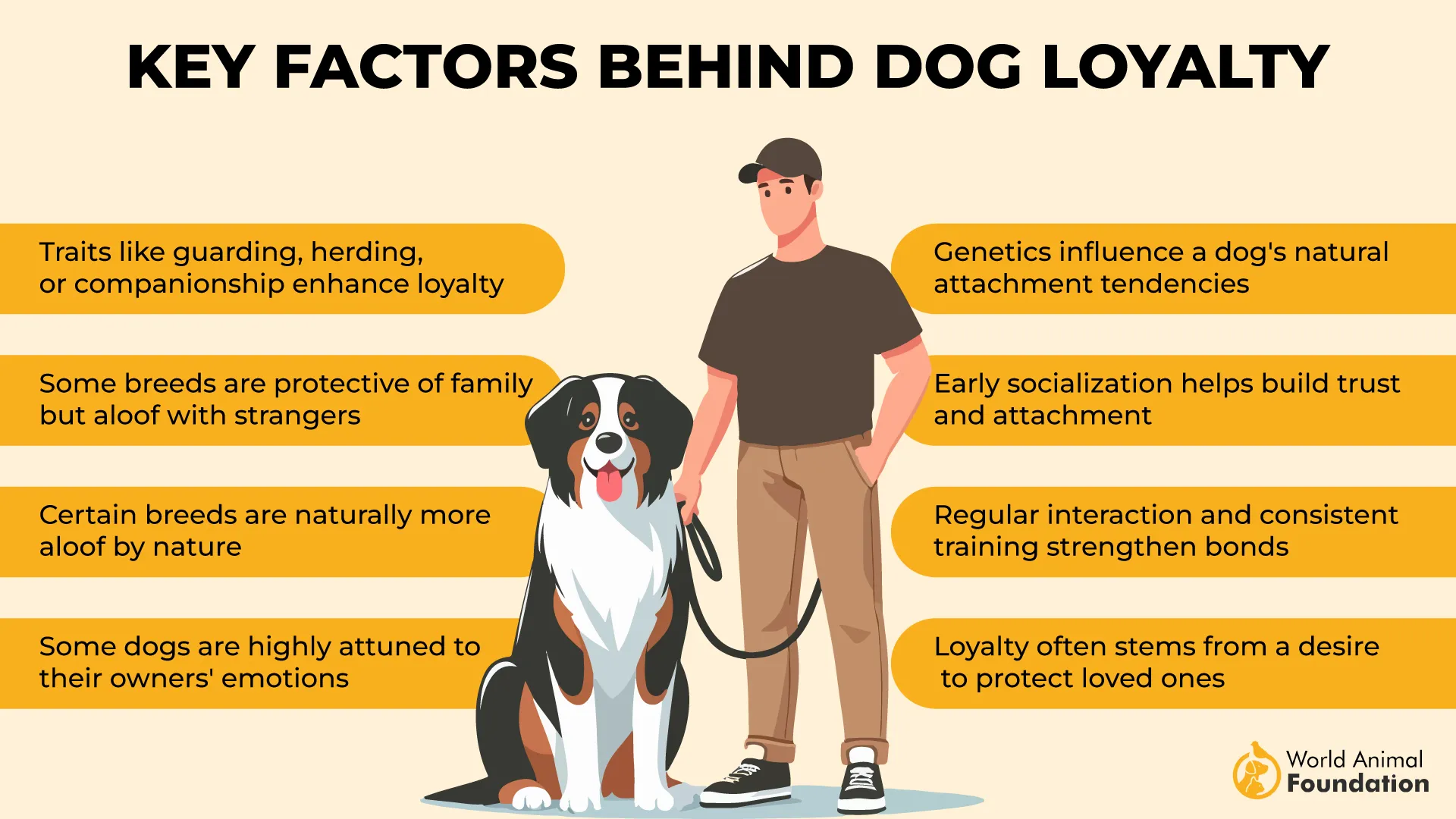
Despite their rugged look, grooming is easy. Their short, sleek coat sheds year-round but only needs a weekly brushing. Occasional baths, along with regular nail trims, ear checks, and dental care, will keep them healthy and tidy.
5. Koolie
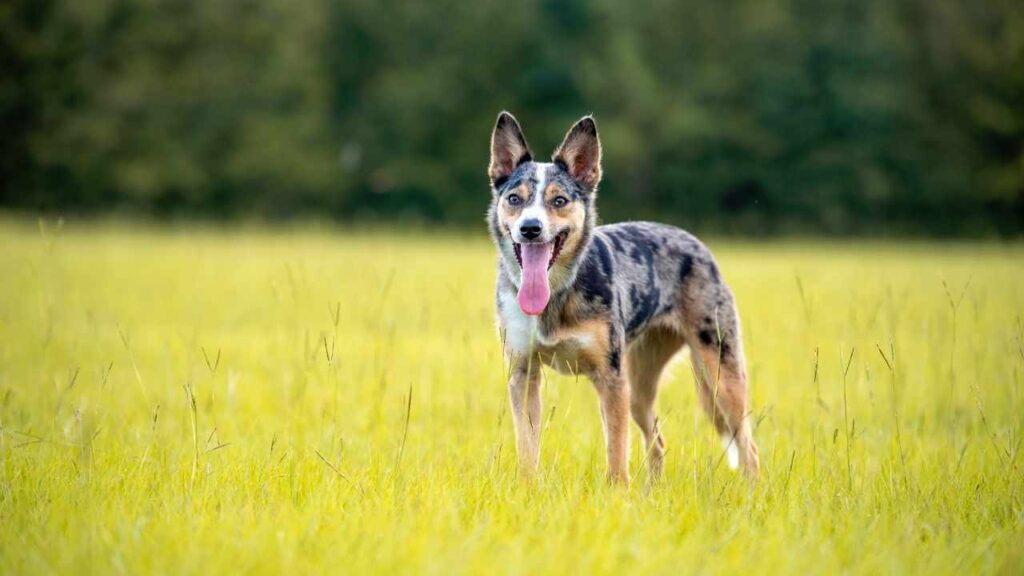
Straight from 19th-century Australia, the Koolie is a high-energy, highly intelligent herding dog built for work and eager to please. Medium-sized with a lean, athletic build, these dogs are happiest when given a job—whether it’s managing livestock, playing fetch, or keeping an eye on the family. Their strong work ethic is matched by their affectionate nature, making them loyal companions with a big heart.
These dogs come in a wide range of appearances, thanks to breeding for function over form. Their coats can be solid, merled, or tricoloured, and eye colours range from warm browns to piercing blues—even mismatched pairs. Ears may stand up or flop, adding to their one-of-a-kind look. Their overall appearance may vary, but all Koolies share the same spirited energy.
Koolies are quick learners who thrive on both physical activity and mental stimulation. Whether herding animals or helping in daily routines, they’re always ready to jump in. While generally friendly and not known for aggression, their alertness and bark make them solid watchdogs. They aren’t natural guard dogs, but their keen awareness ensures nothing goes unnoticed.
Koolies are affectionate and people-oriented, bonding closely with their families. They typically get along well with children and other pets, but their herding instinct may kick in without enough daily activity. They’re best suited for active homes where their energy and intelligence are channeled productively.
Generally robust and long-lived, Koolies can be prone to hip dysplasia, especially if not kept fit. Merle-patterned dogs may carry risks of inherited deafness or vision issues, so responsible breeding practices and early health screening are important. Routine vet care and a healthy lifestyle support their well-being.
6. Great Dane
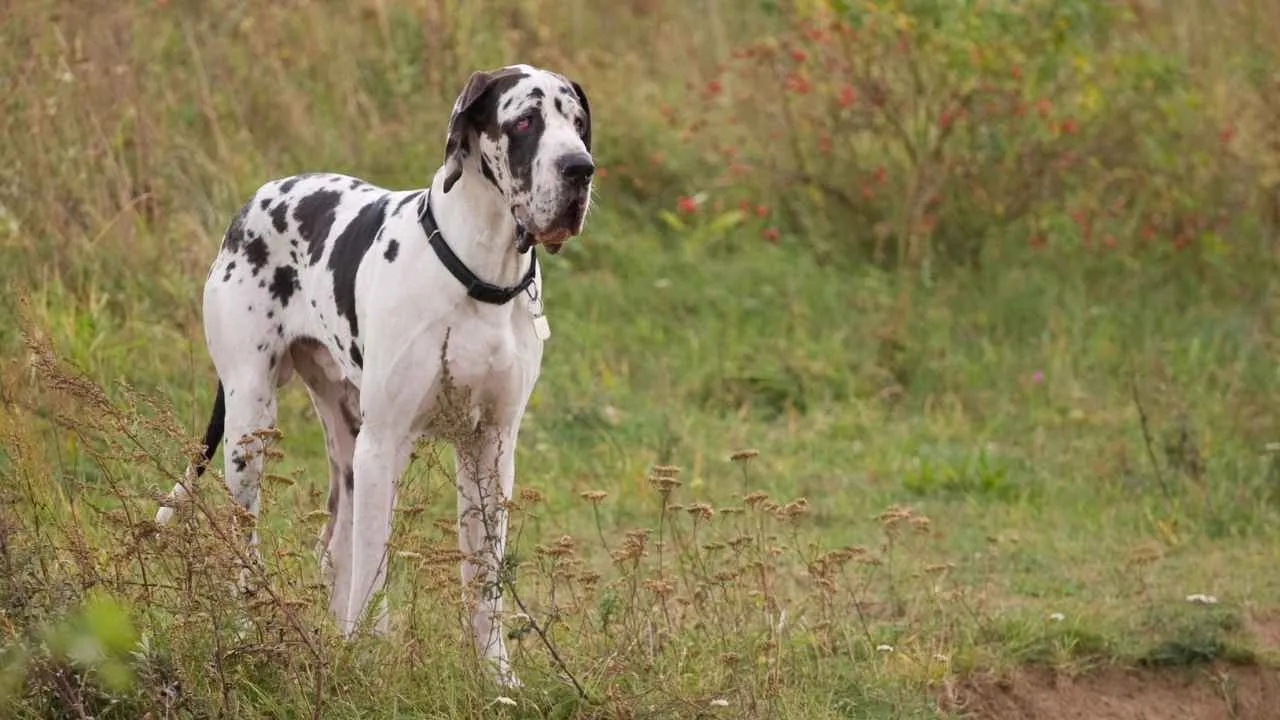
Big, lovable, and full of heart, the Great Dane truly earns its nickname as the “gentle giant.” Originally from Germany, this towering breed combines strength and elegance in a sleek, muscular frame. Despite their imposing size, these dogs are incredibly affectionate and gentle.
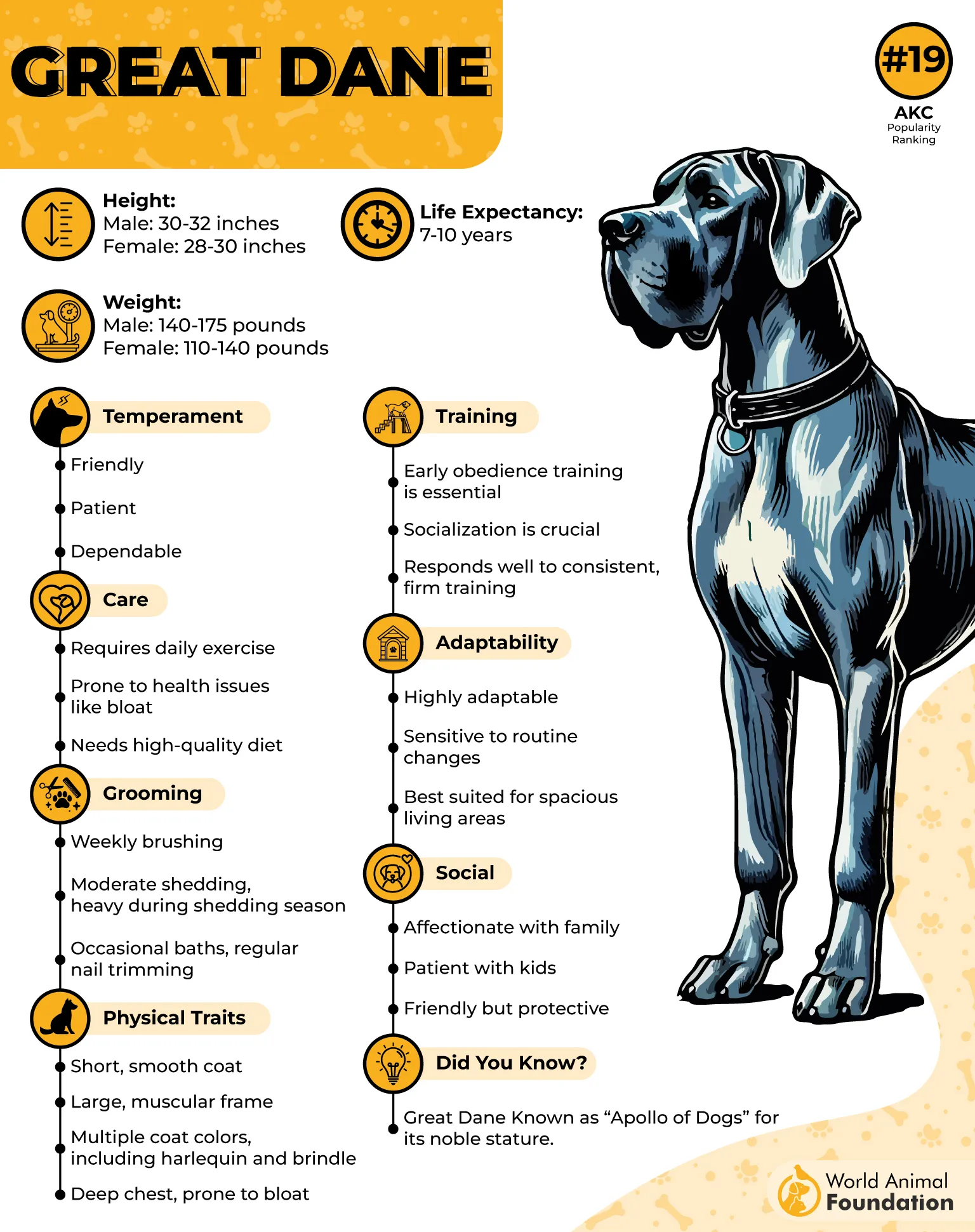
Great Danes thrive on human companionship and are known for their laid-back temperament. They’re great with children, friendly with guests, and surprisingly well-suited to apartment living—make room for a dog who thinks it belongs in your lap. While not overly energetic, they benefit from daily walks to stay fit and happy.
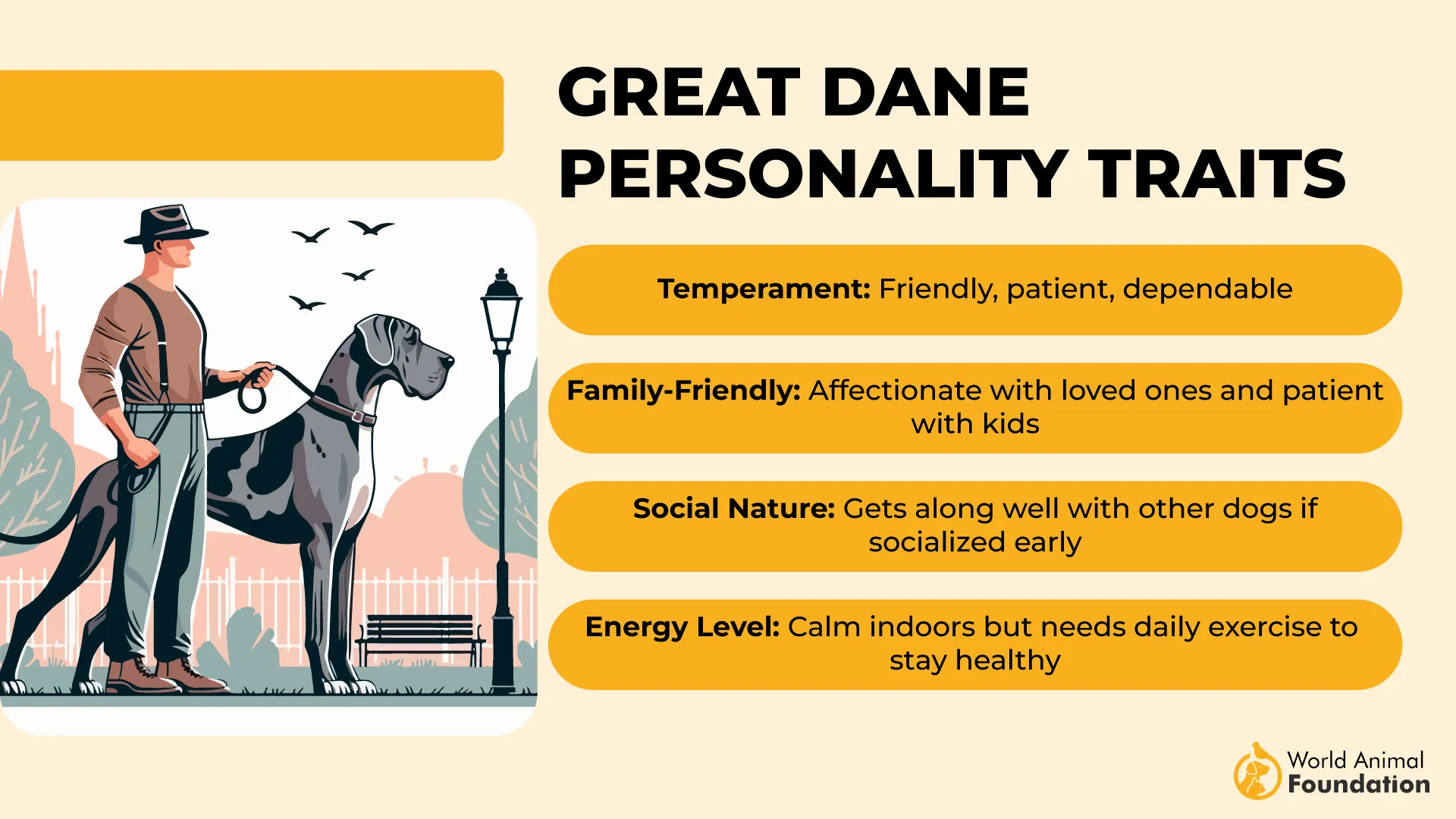
The merle Great Dane is especially eye-catching, sporting a light gray base mottled with darker patches that create a marbled effect. Though not rare, this coat variation adds a unique flair to the breed’s already impressive appearance.
Merle Danes come in a variety of shades, including blue, chocolate, brindle, solid, and mantle merle. Their coloring may shift subtly with age, so don’t be surprised if your pup’s coat evolves over time.
Genetically, merle can appear even when one parent isn’t visibly merle, especially when harlequin genes are in play. However, breeding two merle parents is strongly discouraged due to potential health issues like hearing or vision problems in the offspring.
Did You Know?
A double merle Great Dane inherits two copies of the merle gene, resulting in a predominantly white coat and a high risk of sensory issues like deafness and blindness due to reduced pigmentation in the skin and eyes.
This lack of pigment also makes them more sensitive to sunlight, so limiting exposure during peak hours and prioritizing indoor living is essential to protect their health.
First-time dog owners should be especially aware of these inherited health risks, as double-merle dogs can face serious complications without proper care and responsible breeding.
7. Shetland Sheepdog

Don’t let their dainty size fool you—Shetland Sheepdogs, or Shelties, are packed with energy, intelligence, and heart. Originating from Scotland’s rugged Shetland Islands, they were bred to herd livestock with agility and precision. Though they resemble miniature Collies, Shelties are a distinct breed known for their alertness and quick wit.
Standing 13 to 16 inches tall and weighing 15 to 25 pounds, Shelties are both elegant and nimble, according to PetMD. Their striking appearance features a wedge-shaped head, expressive ears, and a long, luxurious double coat that comes in various colors, most notably the dazzling Blue Merle. That beautiful coat does require regular care, with weekly brushing to prevent mats and manage shedding.
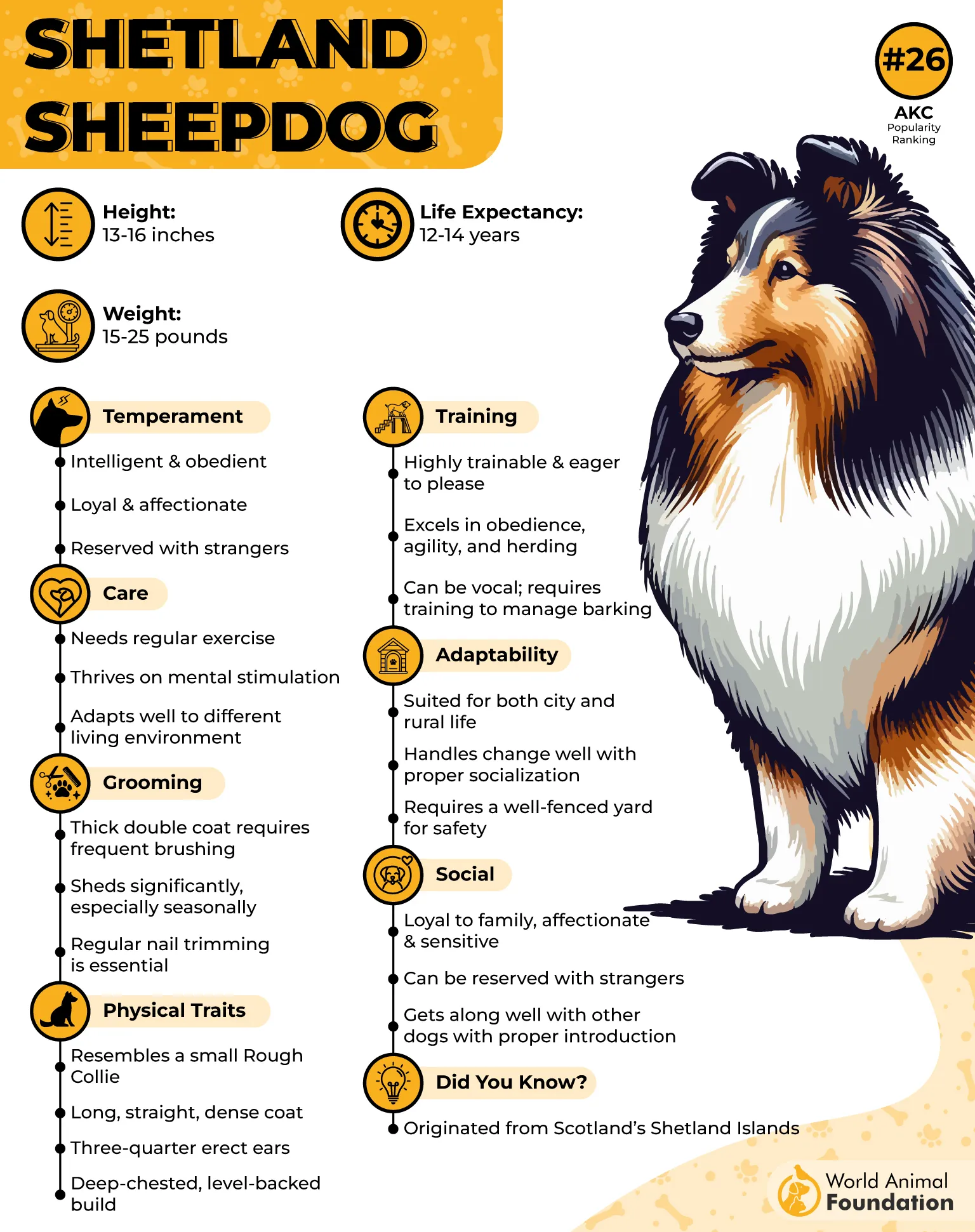
Shelties are loyal breeds who thrive on mental stimulation and structured activity. They excel in obedience and agility sports and love to learn new tasks. Friendly with family but cautious with strangers, they can be vocal, especially when something feels out of place.
Blue Merle Shelties share the same spirited personality as other Shelties but stand out with a unique coat pattern. Their fur blends soft grays, black patches, and sometimes hints of white or tan, creating a marbled, shimmering effect. Despite the name, the coat isn’t truly blue—it’s the result of a gene that lightens black pigment into a cool-toned hue.
This variation is less common due to the care needed in breeding for the merle gene, making Blue Merles especially sought after. Variants like sable merle or bi-blue also exist, each with its own artistic flair.
Conclusion
Merle dog breeds, from merle French Bulldogs, merle chihuahuas, and merle Corgis to merle Poodles and Shelties, showcase striking mottled patches and unique coat patterns, setting them apart from non-merle dogs.
While merle inherited traits can enhance a dog’s appearance, responsible dog breeders avoid breeding two merle dogs to prevent health problems common in entire litters, such as vision and hearing issues. Whether it’s a smooth Collie with darker shades, a toy poodle with a short coat, or medium-sized companion dogs like the Bergamasco Shepherd, understanding the merle breed temperament is key.
Properly trained and cared for, these beautiful dogs—ranging from lap dogs to active herders like German Shepherds—make loyal pets, but pet parents should always prioritize health over aesthetics to maintain breed standards and wellbeing.


